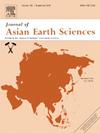In3+-Cl− complexation in hydrothermal fluids: Insights from ab initio deep potential molecular dynamics
IF 2.7
3区 地球科学
Q2 GEOSCIENCES, MULTIDISCIPLINARY
引用次数: 0
Abstract
Given the rising global demand for indium (In) in electronic devices, research has increasingly focused on its natural mineralogy. The transportation and enrichment of indium are primarily driven by magmatic-hydrothermal processes. However, the speciation of In3+ in hydrothermal fluids remains poorly understood. This study developed a first-principle-based deep potential model for the InCl3-H2O system aimed to investigate the species of In-Cl complexes. The dissociation pathways of In3+-Cl− complexes and the corresponding association constants (logK) for were investigated via deep potential molecular dynamic simulations (DPMD). These new thermodynamic properties provide the first dataset on dissociation in high P-T fluids (up to 800 °C and 50 kbar). The Helgeson-Kirkham-Flowers (HKF) parameters for In-Cl complexes were fitted with our DPMD derived logK for In-Cl complexes, which can be serves as a pioneering framework for understanding the stability and speciation of In-Cl complexes in hydrothermal fluids, particularly in the absence of current experimental data. Thermodynamic modeling reveals that In3+ has a strong chemical affinity for Cl−, with high-order In-Cl complexes (InCl3 and InCl4-) playing a critical role in indium transport. Notably, InCl4- becomes the predominant species in a very low NaCl concentration (< 1 wt%). Its chemical affinity for Cl− is stronger than Sn2+, and the chemical-physical conditions that favor Sn2+-Cl- complex transportation are equally conducive to indium, resulting in their co-transport when they share the same source. Indium and zinc exhibit similar speciation in hydrothermal fluids, which may advantageously promote the substitution of indium into sphalerite.

求助全文
约1分钟内获得全文
求助全文
来源期刊

Journal of Asian Earth Sciences
地学-地球科学综合
CiteScore
5.90
自引率
10.00%
发文量
324
审稿时长
71 days
期刊介绍:
Journal of Asian Earth Sciences has an open access mirror journal Journal of Asian Earth Sciences: X, sharing the same aims and scope, editorial team, submission system and rigorous peer review.
The Journal of Asian Earth Sciences is an international interdisciplinary journal devoted to all aspects of research related to the solid Earth Sciences of Asia. The Journal publishes high quality, peer-reviewed scientific papers on the regional geology, tectonics, geochemistry and geophysics of Asia. It will be devoted primarily to research papers but short communications relating to new developments of broad interest, reviews and book reviews will also be included. Papers must have international appeal and should present work of more than local significance.
The scope includes deep processes of the Asian continent and its adjacent oceans; seismology and earthquakes; orogeny, magmatism, metamorphism and volcanism; growth, deformation and destruction of the Asian crust; crust-mantle interaction; evolution of life (early life, biostratigraphy, biogeography and mass-extinction); fluids, fluxes and reservoirs of mineral and energy resources; surface processes (weathering, erosion, transport and deposition of sediments) and resulting geomorphology; and the response of the Earth to global climate change as viewed within the Asian continent and surrounding oceans.
 求助内容:
求助内容: 应助结果提醒方式:
应助结果提醒方式:


